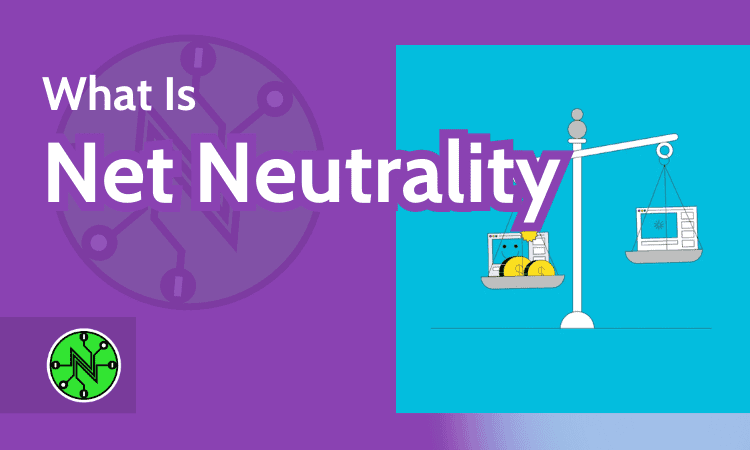
Net neutrality has been a hot-button issue over the past two decades, sparking intense debates and policy changes in the United States and around the world. The principle of net neutrality governs how internet service providers (ISPs) treat data on the internet, preventing them from discriminating against different types of online content.
This principle has been pivotal in maintaining the internet as a platform for innovation, free expression and economic growth. However, the journey of net neutrality has been fraught with contention, policy reversals and ongoing legal battles that reflect the struggle between regulatory oversight and the interests of powerful network owners.
This article will dive into the definition of net neutrality, take a look at its historical timeline, examine its pros and cons, and provide real-world examples. As we delve into the complexities of net neutrality, we’ll uncover not just a policy issue, but also a fundamental question about the future of the internet and its role in society.
Learn more about our editorial team and our research process.
-
04/25/2024 Facts checked
Rewritten to reflect the return of net neutrality regulations in the United States.
What Is Net Neutrality and Why Is It Important?
Net neutrality is the guiding principle that internet service providers should treat all internet traffic equally, without discrimination or preferred access based on user, content, website, platform, type of device or communication method. This means ISPs cannot block, slow down or charge more for certain websites, apps or online services.
The concept of network neutrality is a cornerstone of preserving the free and open internet, granting users equal opportunity to access any legal online services they choose without impediment from internet service providers. This prevents ISPs from giving unfair advantage to their own services or restricting access to their competitors.
How Does Net Neutrality Work?
According to the principles of net neutrality, ISPs and other broadband providers are required to transmit all data at the same speed and quality, without prioritizing or degrading certain types of internet connections, web pages or internet services. This ensures users can access any legal services on the internet without interference or discrimination from their internet provider.
A Timeline of Net Neutrality History
The general idea of net neutrality first became a topic of debate with the popularization of the internet in the 1990s, but it wasn’t until 2003 that the concept crystalized and took concrete form. Since then, various legislation has been introduced to regulate U.S. broadband providers. The following is a timeline of the history of net neutrality in the United States:
- 2003: Columbia University Professor Tim Wu coins the term “net neutrality.”
- 2004: The FCC under President Bush releases a statement highlighting the importance of preserving the freedom of the internet.
- 2005: The Federal Communications Commission (FCC) adopts the net neutrality principles, establishing guidelines for ISPs to follow in managing internet traffic.
- 2008: Net neutrality rules meet their first challenge when Comcast begins throttling users’ speed when using BitTorrent.
- 2010: The D.C. Circuit Court of Appeals overturns the FCC’s enforcement action against Comcast, ruling that the FCC lacked the proper jurisdiction to enforce net neutrality principles in that case. The FCC adopts new rules in response.
- 2014: The D.C. Circuit overturns the FCC’s new rules, as it still lacked the authority to enforce net neutrality decisions under Title II of the Communications Act.
- 2015: The FCC under the Obama administration reclassifies broadband providers as common carriers under Title II of the Communications Act, placing them under its own purview for enforcement purposes.
- 2016: The D.C. Circuit Court of Appeals finally accepts the FCC’s net neutrality rules.
- 2017: Under new leadership, the FCC votes to repeal net neutrality rules, eliminating the Title II classification for broadband providers and once again removing ISPs from its jurisdiction.
- 2019: The repeal of net neutrality rules is challenged in court, with the Federal Appeals Court ultimately ruling to uphold the FCC’s decision.
- 2020: Several states, including California and Washington, enact their own net neutrality laws in response to the federal repeal, ensuring net neutrality protections within their borders.
- 2023: The FCC under Chairwoman Jessica Rosenworcel proposes new rules that once again classify broadband providers as telecommunication services, placing them back under the FCC’s jurisdiction.
Net Neutrality Laws and Regulations
The United States and the European Union have been at the forefront on the issue of net neutrality, though other countries have joined in to enact its principles as law. Here is an overview of some of these countries:
1. United States
The concept of net neutrality first emerged in the United States. Despite a period where the FCC refused to enforce network neutrality, it is now again within its purview, ensuring regulations are fully enforced.
2. European Union
As of November 2015, Article 3 of EU Regulation 2015/2120 sets out a fundamental framework that guarantees internet neutrality across the entire region. This regulation emerged from European Commission deliberations in 2007.
3. United Kingdom
Having left the EU, the U.K. is no longer beholden to the Union’s net neutrality regulations. However, the country’s net neutrality legislation is still based on EU guidelines and there’s no talk of repealing it, as it would likely be seen as an unpopular choice.
Ofcom (the U.K.’s telecoms regulator) revised the U.K.’s net neutrality rules in 2023 to allow ISPs to offer “premium services” and other tailored packages, such as ones that would work better on 5G networks or with certain applications. These changes hinge on the ISP making it clear to the user what the package entails.
4. The Rest of the World
Other countries around the world have their own track records regarding regulations, or lack thereof, for IPSs. Some examples include:
 China: No net neutrality regulations are in place.
China: No net neutrality regulations are in place. Russia: Russia does not uphold net neutrality, as regulations from 2007 let ISPs throttle P2P and other traffic deemed hazardous to a provider’s network. Since 2016, Russian ISPs have not been allowed to restrict access to websites of their own volition; they can only do so for websites already blocked by the government.
Russia: Russia does not uphold net neutrality, as regulations from 2007 let ISPs throttle P2P and other traffic deemed hazardous to a provider’s network. Since 2016, Russian ISPs have not been allowed to restrict access to websites of their own volition; they can only do so for websites already blocked by the government. India: India prohibited differential pricing in 2016 and authorized further net neutrality regulations in 2018. As a result of net neutrality rules, some broadband providers such as Facebook (now Meta) shut down operations in India.
India: India prohibited differential pricing in 2016 and authorized further net neutrality regulations in 2018. As a result of net neutrality rules, some broadband providers such as Facebook (now Meta) shut down operations in India.
The Pros and Cons of Net Neutrality
The net neutrality debate is often fought along party lines in the U.S., despite it benefitting all internet users equally. These are some of the alleged benefits and drawbacks of net neutrality.
Net Neutrality Examples
Some examples of how net neutrality laws impact users and companies include:
- Meta’s Free Basics program allowed disadvantaged users in certain countries free access to the internet but unwittingly charged for access to photos, videos and other services. As this was in clear violation of net neutrality, and India’s regulations in particular, the provider pulled out of India when the country codified these regulations.
- Comcast’s tussle with the FCC shaped today’s net neutrality rules. The company was found to be intentionally slowing down peer-to-peer traffic and allegedly throttling traffic flowing toward Netflix and other streaming services. Complaints started pouring in in 2007, and the FCC enforced its regulations with Comcast the following year.
- YouTube and Netflix are among the most prominent net neutrality proponents. Video streaming requires a lot of bandwidth, comprising a whopping 65% of all internet traffic in the U.S. Deregulation would disproportionately impact streaming services, as net neutrality prevents extra charges to access streaming content or high-quality streaming.
Final Thoughts
Net neutrality remains a complex and often contentious issue, with more or less valid arguments on both sides. However, the fundamental principle of treating all internet users equally is critical to maintaining a free internet that fosters innovation, protects user rights and ensures equal internet access for all.
As the digital landscape continues to evolve, the debate around net neutrality will likely continue, with policymakers, broadband providers and internet users all vying to shape the future of the open internet. What are your thoughts on net neutrality? Have you ever faced ISP throttling? Let us know in the comments below, and as always, thank you for reading.
FAQ: Net Neutrality Definition
-
The principle of net neutrality dictates that no ISP can throttle, block access to or otherwise discriminate against certain types of internet traffic. This means that an ISP can’t charge you more for streaming, charge fees for “premium traffic” or block legal websites and other content. It also prevents ISPs from slowing down your internet while streaming or torrenting.
-
People who are against net neutrality are usually those who can benefit from its repeal, such as wealthy ISP owners, or those who prefer the neoliberal approach of deregulating all aspects of the free market.
-
Yes, as of December 2023, net neutrality is back on the menu in the U.S. following a five-year break.
-
Net neutrality has no downsides for users in a practical sense. All arguments against net neutrality revolve around ISPs making less money by not being able to charge users more for high-demand traffic like streaming. According to opponents, this could lead to stagnation in innovation, though history has proven otherwise.
Sources:
- https://docs.fcc.gov/public/attachments/DOC-397235A1.pdf
- https://www.freepress.net/issues/free-open-internet/net-neutrality/net-neutrality-what-you-need-know-now
The post What Is Net Neutrality? Definition, Pros & Cons and Examples in Simple Terms in 2024 appeared first on Cloudwards.



 China: No net neutrality regulations are in place.
China: No net neutrality regulations are in place. Russia: Russia does not uphold net neutrality, as regulations from 2007 let ISPs throttle P2P and other traffic deemed hazardous to a provider’s network. Since 2016, Russian ISPs have not been allowed to restrict access to websites of their own volition; they can only do so for websites already blocked by the government.
Russia: Russia does not uphold net neutrality, as regulations from 2007 let ISPs throttle P2P and other traffic deemed hazardous to a provider’s network. Since 2016, Russian ISPs have not been allowed to restrict access to websites of their own volition; they can only do so for websites already blocked by the government. India: India prohibited differential pricing in 2016 and authorized further net neutrality regulations in 2018. As a result of net neutrality rules, some broadband providers such as Facebook (now Meta) shut down operations in India.
India: India prohibited differential pricing in 2016 and authorized further net neutrality regulations in 2018. As a result of net neutrality rules, some broadband providers such as Facebook (now Meta) shut down operations in India. 